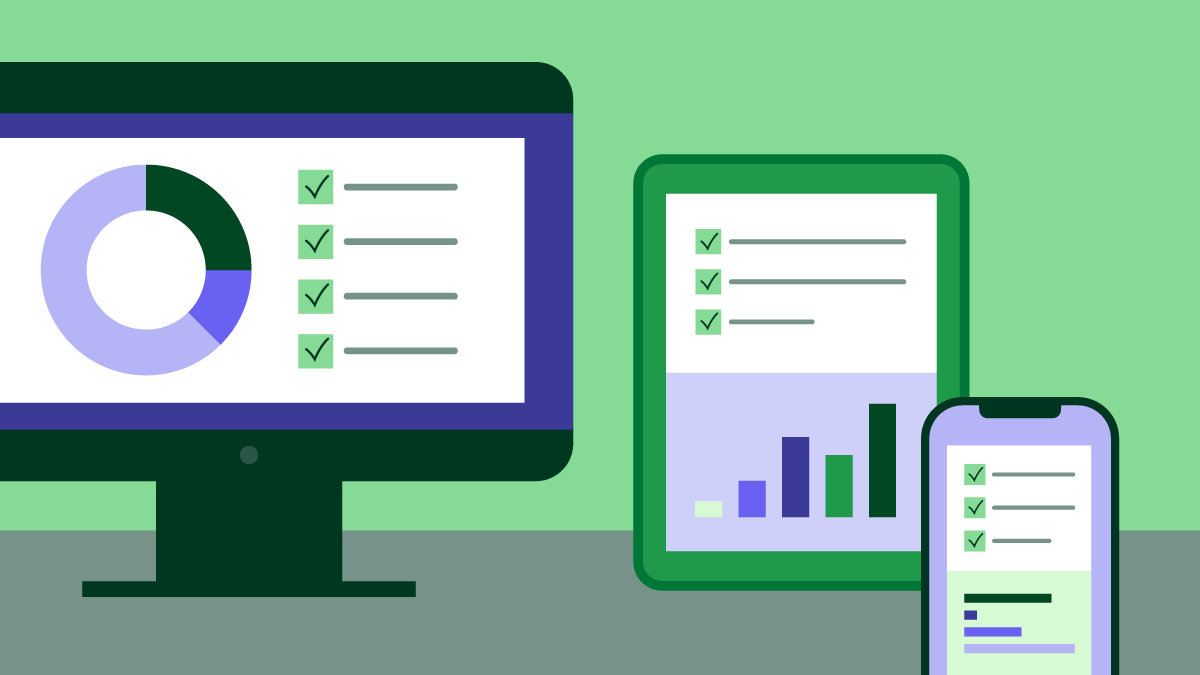Do you know what your customers are thinking? Understanding what’s going on in your customers’ minds means you can provide a more valuable service that meets their most pressing needs.
Customer surveys make this possible. They provide fresh insights into your customer’s needs and pain points to improve your marketing and sales activity.
In this article, we’ll share how you can use customer surveys to improve your processes. You’ll learn the type of questions to ask and how to set up your survey, along with several customer satisfaction survey examples to help you get started.
What is a customer survey and how can it improve the buying journey?
Businesses use customer surveys to reach out to existing or past customers and collect their feedback. These surveys are commonly used to measure customer satisfaction, but businesses can also use them for market research, to test new ideas and anything else where customer input is needed.
This makes them particularly useful for marketing and sales teams, who can use survey results to analyze and optimize how they interact with customers.
Get feedback from a wide range of customers
It would be great to personally interview every single customer, but the process takes so much time that it’s not viable for most businesses. In contrast, online surveys are easy to scale and can be used to quickly gather feedback from your entire customer base.
Rather than focusing exclusively on a small number of companies that meet your ideal customer profile (ICP), surveys allow you to collect a variety of perspectives in a relatively short amount of time.
While you can send a survey to all your customers, you can also include them in an email autoresponder sequence to reach out to specific segments, such as:
Inactive customers who haven’t purchased in three months
Highly active customers who buy weekly
New customers who’ve recently purchased a specific product or service
Customers who’ve recently been in contact with your customer success team
Prospects who’ve reached a specific stage in the pipeline
Used this way, customer surveys can help you efficiently understand different attributes of your customer and client base, including their main challenges and objectives.
Build more meaningful relationships with prospects
Asking for feedback shows customers that you’re committed to their ongoing satisfaction and success. A survey also helps you stay top of mind with the customer by encouraging them to think back on the user experience.
By proactively asking customers to share their thoughts and opinions, you get to know them better. You can then use those insights to identify any areas where you can improve the customer journey, planning your marketing and sales around your customers’ priorities.
Share content that resonates with your ideal customer profile (ICP)
When marketers were asked to rank the top factors that contributed to a successful content strategy, the ability to understand and connect with the customer’s values, interests and pain points was the most popular answer by far.

With a customer survey, you can ask your customers that match your ICP what those values, interests and pain points are. You can find out what type of content your ICP prefers and how they consume it, then use that information to create a more relevant content marketing plan.
Using open-ended questions in your survey helps you capture valuable voice-of-customer (VOC) data, so be sure to vary your question styles (more on this later). VOC data informs your messaging, so you can talk to your customer using language that resonates with them.
Produce targeted sales enablement resources
Sales teams do their best work when they have all the resources and tools they need to engage with prospects. This means knowing who those customers are, what their journey looks like and how your sales process complements that journey.
Use customer surveys to find out what kind of content and information they’d benefit from at each stage of the customer journey. Salespeople can then leverage those resources for the right buyer segments at the right time.
For example, use customer surveys to collect testimonials and results. This provides excellent social proof to use in your sales collateral.
You can also use the insights to create sales training and other resources that help your sales team nurture leads and close more deals.
Increase revenue through cross-selling and upselling
Customer surveys can tell you a lot about the customer’s priorities at different stages in the buying process, including post-purchase. As new challenges and motivations come up, this will help your sales team identify the best opportunities and timing to pitch additional products or services.
When your cross-selling and upselling complements the customer’s needs, it’s a win-win scenario. Your customers get more value, relationships grow stronger and you increase revenue.
Types of questions to get insightful responses
To get the best results from your customer surveys, you have to ask the right questions. You’ll first want to narrow down what information you’re looking for (question categories) and then how you’ll ask each question (question styles).
Customer survey question categories
Here are different customer survey question categories you might want to use in your next customer satisfaction survey.
Demographics
Asking questions about demographics can help you learn more about your market and create more accurate buyer personas. These questions uncover details relating to:
Age
Race
Gender
Location
Marital status
Education
Employment
Income
Ask only the most necessary questions. You may already have relevant demographic data in your CRM and asking fewer questions reduces friction, giving your survey a higher response rate.
Limit your questions by only asking those that will have a meaningful impact on marketing and sales so you can provide more value to customers.
Psychographics
Psychographic questions help you understand the customer’s motivations, obstacles and pain points. For example, you might use your customer survey to ask:
Where did you first hear about this service?
What made you choose this product over a competitor?
What’s your biggest business-related challenge right now?
What are you hoping to achieve with this service?
How long did you spend researching this purchase?
Which of the following did you use to research this purchase?
Product or service usage
Similar to psychographic questions, these questions dig a little deeper into how customers view their purchase and how they’re using it to achieve their goals.
Product and service usage questions you could ask include:
Which product features do you find the most useful?
Which product features do you find the least useful?
What’s the biggest benefit to your business of using this service?
Which features do you wish were included in this service?
How easy is the product to use?
For example, this questionnaire from LinkedIn asks respondents about the specific features they’ve used on the platform in the last five days.

Product or service satisfaction and loyalty
If you want to calculate your customer satisfaction score (CSAT), you can use your customer survey to ask a question such as:
How satisfied were you with the product?
How would you rate your overall satisfaction with the service?
The customer is then able to rate their satisfaction on a numbered scale, typically one to five or one to ten.
In these customer satisfaction survey questions from LinkedIn, respondents can rate their satisfaction with different features on a scale of zero to ten, where zero means they’re not at all satisfied and ten means they’re very satisfied.

If you were more interested in customer loyalty and wanted to calculate your net promoter score (NPS), you’d ask the following question:
How likely is it that you would recommend this product to a friend or colleague?
Respondents can then rate that likelihood on a scale of one to ten. We’ll cover more about how these scales work in the next section.
Follow-up
There will most certainly be occasions where you wish you could ask a follow-up question. Including a final question asking if the customer would be willing to discuss their responses opens the door to a follow-up survey or interview.

Customer survey question styles
Varying the style of question helps respondents think more critically and offers a variety of insights. Here are different customer survey question styles to apply to your next survey.
Binary
A binary question gives respondents two choices (usually a yes/no question). They’re the easiest to answer, but they only work when you’re interested in absolutes. For example:
Was the product delivered on time?
Did the customer service rep resolve your issue?
Did you find what you were looking for?
Multiple choice
A multiple-choice question lets respondents select their answer from a list of available options. Depending on your objective, you might limit respondents to just one answer, ask them to select as many answers as apply or rank their answers in order of importance.
For example:
Which of the following features do you use the most?
Which of these competitors did you consider before choosing this service?
Rank the following benefits in order of importance

Open-ended questions
Open-ended questions encourage customers to answer in their own words, which can yield unexpected insights. However, these also require more effort from the respondents, which can reduce the number of responses.
For example:
What three words would you use to describe this product?
Describe the problem you’re solving with this service.
Did you have any additional feedback on your experience you’d like to share?
Rating scale
Also known as Likert scale questions, these allow respondents to rate their attitudes and feelings on a fixed scale. This can be used for measuring CSAT and NPS, as well as other responses which are more nuanced than a simple binary choice.

Setting up a customer survey for your business
An effective customer survey involves more than just sending a bunch of questions to your email list. Use the following step-by-step guide to get your customer survey set up.
1. Define your goal
Your customer survey should have one clear objective. For example, you might use your customer survey to:
Improve buyer personas
Check that you’re meeting customer expectations
Optimize your content marketing
Identify areas for improvement
Measure customer satisfaction and loyalty
Trying to accomplish all of that in one survey will lead to a long, convoluted survey that achieves nothing. Choosing one specific goal will guide the rest of the process and increase the chances you’ll get meaningful responses.
2. Choose the right software
While you can manually send email surveys and review your responses, a dedicated customer survey feedback tool will make the job a lot easier.
The right tool will help you:
Set up the survey
Use different questions formats
Distribute the survey to the right people
Capture and analyze the responses
Present results in an easy-to-understand dashboard
Many survey tools will also optimize your survey for mobile, ensuring that respondents can complete your survey on whatever device they’re using. Some will even allow you to integrate with project management and relationship systems, like your CRM.
Pipedrive has a marketplace catering to hundreds of integrations, including web forms and surveys, so you can automate customer surveys and see your results in one place.

3. Decide who you’ll reach out to
Who you survey will depend on your objective. While you could send the same survey to your entire customer base, different segments will be preferable for different goals.
For example, if you want to know what influenced a purchasing decision, it makes more sense to ask someone who has purchased in the last month. On the other hand, if you want to understand why customers churn, talk to inactive customers who haven’t purchased anything recently.
4. Pick the most important questions
While a customer satisfaction survey template is good for inspiration, you should double-check that you’re asking the right questions for your objective and your customers.
If you just want to measure your CSAT or NPS, you can limit your customer feedback survey to one question. Insurify does just this with their single-question survey sent via email:

Make sure you write your questions carefully, checking for any accidental bias. Stay as neutral as possible and ensure your answers are balanced. For example, asking what the customer thinks of your “awesome” new feature is a leading question that may skew your results.
5. Reach out to your customers
The way you ask customers to complete your survey will have a big impact on your response rate. Explain clearly why you’re reaching out and what the survey involves.

In this example from AppSumo, the email explains:
The purpose of the survey (to better understand the customer’s needs and experience)
What’s in it for the customer (15% off the next purchase)
How long it’ll take (no more than ten minutes)
When the survey closes (June 10, 11:59 pm)
It finishes off with a clear call to action (CTA) to take the survey.
6. Analyze the results
Once you’ve started getting survey responses, look to see if there are any patterns. This is relatively straightforward for quantitative results, such as answers to multiple-choice or ranged scale questions.
For example, with NPS and CSAT surveys, the responses can be used to calculate the relevant metrics, see how you compare against competitors and measure improvement.
Analyzing your open-text responses can be more time-consuming, but it’s worth reading each response carefully. This is the main opportunity for respondents to freely express themselves, providing customer insights you’d never considered. If they’ve taken the time to write a thoughtful response, you should be willing to take the time to read it.
7. Follow up and take action
Always thank the customer for taking the time to complete the survey, whether they’ve given you top marks or not. If you need further clarification on anything they’ve said (and they’ve given you permission to follow up on the survey), reach out as soon as possible while their responses are still fresh in their minds.
It may be that the survey has uncovered issues that need to be urgently resolved, in which case that should be your priority. However, don’t forget your initial objectives.
Go back to your original goal from the first step and ask how you can use what you’ve learned. Share survey results with your marketing and sales teams so that they can make any necessary changes to help attract, close and retain customers.
Customer satisfaction survey best practices
While you’re putting your customer survey together, keep the following tips in mind to maximize your results.
Keep it short
Finding the right length for your customer survey is a real challenge. On one hand, you want to make the most of the opportunity to get as much useful customer feedback as possible.
However, if the survey takes too long to complete, you will get fewer responses.
Even if respondents still complete your survey, the quality of response can decrease. One report found that a large number of survey respondents on a certain platform failed attention checks and, as a result, delivered low-quality data.
To keep attention high and reduce the chances of “survey fatigue”, ask if every question is necessary. How does it help your objectives for the survey? If it doesn’t serve a specific purpose, cut it out.
Consider using an incentive
While they’re not mandatory, offering respondents some kind of reward for completing your survey will usually result in higher response rates.
This can be especially helpful if you have a limited set of customers to survey or the survey is particularly complex or time-consuming.

Offering a discount on future purchases is great if you’re trying to appeal to loyal customers, but the incentive could bias the results if you’re measuring customer satisfaction levels. Your least satisfied customers might not be swayed by a discount, so you’ll want to ensure you’re reaching them too. “Money back” on a recent purchase is one way around this.
The ideal incentive will be valuable to the right prospect without unduly influencing the survey results.
Timing is everything
When you send your customer survey is almost as important as when you send it. For example, over 70% of respondents said they would like or love to respond to a survey request immediately after getting their complaint resolved. On the other hand, over 50% said they’d dislike or hate getting a survey in the middle of a live support chat.
You can also send surveys at different times to get a better understanding of different stages in the customer lifecycle.
For example, sending a survey immediately after someone signs up for your service is an ideal time to get insights on factors influencing their purchasing decision. The same survey sent a week later will shed more light on the onboarding process, while sending it a month later could shed light on long-term satisfaction and any issues that could cause churn.
The following email from Deliveroo was sent immediately after a customer interaction with the customer support team, making it an ideal opportunity to measure how support staff engagement affects customer loyalty.

Final thoughts
Customer surveys are an invaluable tool for marketers and salespeople, allowing them to find out more about their customers, nurture them effectively and close more deals.
Getting the best results takes careful planning. You’ll need to ask the right questions to the right people at the right time to get meaningful responses. However, those insights can be used in lots of different ways, from improved marketing campaigns and after-sales service to more relevant sales enablement.
When customers share their thoughts and opinions, you can strengthen relationships and improve the customer experience, leading to increased customer retention and revenue.








